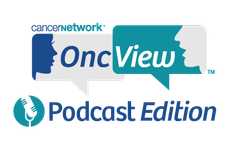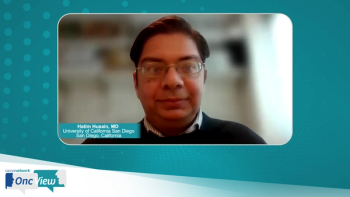
Use of Tazemetostat in R/R FL
Connie Batlevi, MD, PhD, explains the recent approval of tazemetostat, as well as the use of molecular testing in follicular lymphoma.
Episodes in this series
Kristie L. Kahl: I know you just mentioned it, but can you also discuss the recent approval of tazemetostat, the study design, and what this means for this patient population?
Connie Batlevi, MD, PhD: Tazemetostat is an EZH2 inhibitor. EZH2 is what we call a histone methyltransferase, and their function is to wind and unwind the DNA to control how oncogenes—genes that drive cancers—are either expressed or not expressed. EZH2 is important for B cell development. Germinal center B cells need this control to decide to grow, or to not exit from the germinal center. It’s involved in the immune signals and a terminal differentiation of B cells. EZH2 mutation happens in about 15% to 25% of follicular lymphoma and the mutation basically enhances this activity of the methyltransferase so that it adds on a third methyl group. Tazemetostat is an inhibitor of this.
When they did the phase 2 clinical trial that led to its approval, we looked at 2 groups of patients: Patients that are EZH2 mutated and patients that are EZH2 wild type. The patients had to have 2 or more prior therapies. The drug was given 800 mg twice a day, orally. We did see responses in both. There was a heightened sensitivity to the response in EZH2 mutant patients. In the mutant patients, the overall response rate was about 70%, and in wild type, it was about 35%. But in either group, about 20% of the patients, there was a durability of this response beyond 18 months. Furthermore, the drug has a favorable safety profile. Less than 5% of patients discontinued therapy and less than 10% required dose reduction. The most common adverse effects [AEs] were nausea, diarrhea, thinning of the hair that is not total hair loss, and some fatigue. Even though all grade events were common, AEs that were grade 3 or more represented 5% of the population.
When tazemetostat received FDA approval, it was approved in patients with relapsed/refractory follicular lymphoma who had an EZH2 mutation, and they had at least 2 prior treatments. They also approved the drug in patients who had relapsed/refractory disease who didn’t have satisfactory treatment options, either based on AE profiles, comorbidities, or the types of preferences that the patient had.
Kristie L. Kahl: What are the implications of this approval on the treatment landscape?
Connie Batlevi, MD, PhD: In terms of this treatment approval, we must keep in mind that this becomes one of the first targeted therapies for follicular lymphoma, and this will open new doors in terms of how we can use genetic profiling and personalized medicine to do more treatments in lymphoma. In terms of this particular drug, because of its favorable safety profile, there are ongoing clinical trials to test this in combination with other treatments. There are clinical trials studying addition of rituximab with tazemetostat. This makes sense because, at least in nonhuman models in the laboratory, they showed that there was some synergism to the addition of the 2. Similarly, there is a clinical trial with the combination of rituximab, lenalidomide, and tazemetostat in the second-line setting. There’s also going to be broadening of tazemetostat in the upfront setting, and there has been existing trials that studied the combination of this with R-CHOP [rituximab, cyclophosphamide, doxorubicin, vincristine, and prednisone] to see if there were any additional AE profiles that we missed. So far, in terms of the AE profile, the performance has been quite satisfactory.
Kristie L. Kahl: What factors do you consider when choosing a treatment option for each patient?
Connie Batlevi, MD, PhD: As we discussed before, it’s patient-dependent, depending on all of the parameters that make them, them. Their functional status, their social support system, the types of treatment that they’ve had in the past, how robust they are to get treatment now, and what the pace of their disease is as they are entering treatment. It is not a one size fits all scenario, and it’s hard to individualize or make blanket treatment decisions.
Kristie L. Kahl: Can you discuss the role of PI3 kinase inhibitors for relapsed/refractory follicular lymphoma in the third-line or later?
Connie Batlevi, MD, PhD: We have 4 FDA-approved PI3 kinase inhibitors for follicular lymphoma in the third-line or beyond. There’s idelalisib, duvelisib, copanlisib, and umbralisib. Each targets slightly different PI3 kinase isoforms. For example, idelalisib and duvelisib target gamma/delta, copanlisib is a PI3 kinase inhibitor, and umbralisib targets delta and CK1-epsilon. In general, responses are in the 50% range and complete remissions are typically less than 10%. There are some AE profiles that are pertinent for the earlier generation PI3 kinase inhibitors. For example, idelalisib and duvelisib have a risk of colitis and pneumonitis that can affect our patients. Copanlisib—perhaps with the mechanism of how it’s given, which is intravenously approximately once a week—they are able to have less of those colitis and pneumonitis events, but they also see the alpha isoform AEs, such as hyperglycemia and hypertension. Umbralisib is a little similar in that it is the new PI3 kinase that’s available. The AE profile seems to be a bit more tolerated, but overall, there are fewer patients on it so far, so we need to see how it evolves.
Transcript edited for clarity.
Newsletter
Stay up to date on recent advances in the multidisciplinary approach to cancer.
































































































